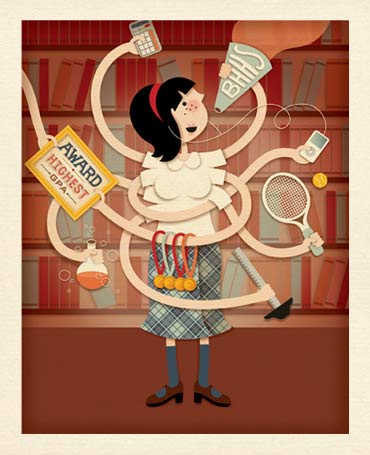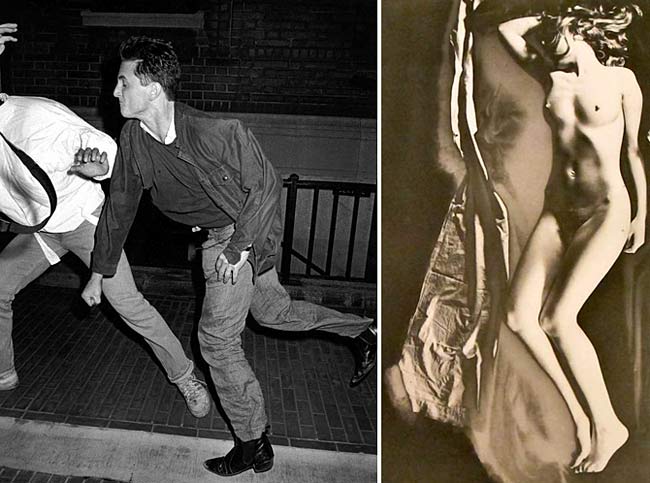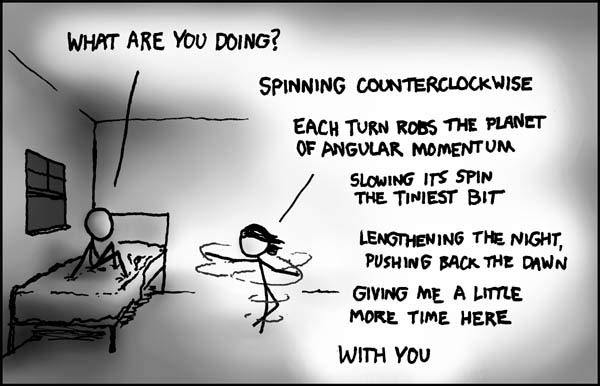Depot, depot

A remote expedition to the deepest layer of the Earth’s oceanic crust has revealed a new ecosystem living over a kilometre beneath our feet. It is the first time that life has been found in the crust’s deepest layer, and an analysis of the new biosphere suggests life could exist lower still. (…)
They found communities of bacteria that were sparse but widespread. (…) This is similar to the bacteria found in oil reservoirs and contaminated soil, which could mean that the bacteria migrated down from shallower regions rather than evolving inside the crust, the team say.
photo { Anthony Suau }
We tote big guns, and everybody know somebody that know somebody that know somethin’ about it

New York City in the 1920s and ’30s was a hotbed of criminal activity. Prohibition laws banning the production, sale and distribution of alcohol had been introduced, but instead of reducing crime, they had the opposite effect. Gangsters organized themselves and seized control of the alcohol distribution racket, smuggling first cheap rum from the Caribbean, then French champagne and English gin, into the country. Speakeasies sprang up in every neighbourhood, and numbered more than 100,000 by 1925. When prohibition was abolished in 1933, the gangsters took to other activities, such as drug distribution, and crime rates continued to increase.
At the forefront of the city’s efforts to keep crime under control was a man named Carleton Simon. Simon trained as a psychiatrist, but his reach extended far beyond the therapist’s couch. He became a ‘drug czar’ six decades before the term was first used, spearheading New York’s war against drug sellers and addicts. He was a socialite and a celebrity, who made a minor contribution to early forensic science by devising new methods to identify criminals. He also tried to apply his knowledge to gain insights into the workings of the criminal brain, becoming, effectively, the first neurocriminologist.
Simon was born in New York City on February 28th, 1871, and studied in Vienna and Paris, graduating with an M.D. in 1890. Afterwards, he conducted sleep research. (…) Eventually, Simon became interested in criminology and psychopathology, and by the turn of the century had abandoned his psychiatric research to focus on these disciplines. (…)
Towards the end of the 1930s crime was estimated to cost the U.S. approximately $15 billion annually. Knowledge of brain function and dysfunction was very rudimentary by today’s standards, and criminals and psychopaths were often lobotomized or subjected to electroconvulsive therapy in order to keep them under control. Another treatment available was insulin shock therapy, which had been introduced by Manfred Sakel in 1933, and involved giving patients large repeated doses of the hormone to induce coma. It was around this time that Simon proposed a new theory, which he believed would help science to understand and control the criminal mind.
The theory drew on the concept of cerebral dominance, which had emerged some 70 years earlier, largely from Paul Broca’s investigations of stroke patients. (…) According to Simon’s theory, criminality occurs as a result of a shift in cerebral dominance, whereby the normally submissive right hemisphere gains mastery of the brain, leading to irrational behaviour.
photo { Alessandro Zuek Simonetti }
Mrs be wise and learn of me
The fact that many bats utilize echolocation to find prey is well-known. This ability is well-developed; some bats even dynamically adjust the width of the sound pulse during the pursuit of prey, thereby broadening their field of view without sacrificing attention, useful for capturing erratically-flying prey.
In contrast, much less is known regarding how echolocating bats utilize sensory cues to recognize their habitat, an ability which is clearly important to their survival. (…)
Ornithologists have investigated how echolocating bats differentiate water, often a prominent feature of their habitat, from other surfaces. Their research demonstrates that echolocation is given prominence even in the face of contradictory sensory cues, and further suggests that this recognition ability is innate (not learned).
Ideas for a Philosophy of Nature

The rite of exorcism, rendered gory by Hollywood and ridiculed by many modern believers, has largely fallen out of favor in the Roman Catholic Church in the United States.
There are only a handful of priests in the country trained as exorcists, but they say they are overwhelmed with requests from people who fear they are possessed by the Devil.
Now, American bishops are holding a conference on Friday and Saturday to prepare more priests and bishops to respond to the demand. The purpose is not necessarily to revive the practice, the organizers say, but to help Catholic clergy members learn how to distinguish who really needs an exorcism from who really needs a psychiatrist, or perhaps some pastoral care.
“Not everyone who thinks they need an exorcism actually does need one,” said Bishop Thomas J. Paprocki of Springfield, Ill., who organized the conference. “It’s only used in those cases where the Devil is involved in an extraordinary sort of way in terms of actually being in possession of the person.
“But it’s rare, it’s extraordinary, so the use of exorcism is also rare and extraordinary,” he said. “But we have to be prepared.”
{ NY Times | Continue reading | related: In Rare Cases, Pope Justifies Use of Condoms }
photos { 1. Brassaï, Graffiti, 1933 | 2. Santiago Mostyn }
I got two, oh Mike all the time. Sweet and sour like a tangerine.

Most jerks, I assume, don’t know that they’re jerks. This raises, of course, the question of how you can find out if you’re a jerk. I’m not especially optimistic on this front. (…)
Another angle into this important issue is via the phenomenology of being a jerk. I conjecture that there are two main components to the phenomenology:
First: an implicit or explicit sense that you are an “important” person. (…) What’s involved in the explicit sense of feeling important is, to a first approximation, plain enough. The implicit sense is perhaps more crucial to jerkhood, however, and manifests in thoughts like the following: “Why do I have to wait in line at the post office with all the schmoes?” and in often feeling that an injustice has been done when you have been treated the same as others rather than preferentially.
Second: an implicit or explicit sense that you are surrounded by idiots.
illustration { David Bray, Better Must Come, 2009 }
Fr’over the short sea, had passencore rearrived from North Armorica

On October 25, family members of a 22-year old Malaysian woman reported her disappearance to police and that the woman had sent them a text message stating that she was being held captive by orang bunian (fairies).
This was not the first disappearance for Siti Balqis Mohd Noor. She had previously reported multiple “strange experiences” in which she apparently vanished into thin air and was later found in unexpected places, including the roof of her house, a nearby cement mixer, and a cemetery ten kilometers from her home. After all of these occurrences, Siti would report that she had no memory of what had happened.

NPR has a fascinating segment about how humans can’t walk in a straight line unless we have an external guide. We just end up walking in circles.
It turns out, no one is really sure why this happens but experiments on walkers, drivers and swimmers have all found the tendency to circle back on ourselves despite us thinking that we’re maintaining a steady course ahead.
photos { Jean-François Lepage | Jeff P. Elstone II }
Beware of elaborate telescopic meat, it will find its way back to the forest

Forensic scientists of the future may soon have a new tool at their disposal. Given a drop of blood, researchers in the Netherlands have roughly determined the age of the person it came from. But for now, it really is rough–the researchers found they could only estimate a person’s age to within 9 years.
Currently, a crime scene investigator who obtained a spot of blood can check its DNA to see if it matches a known suspect or someone in a law enforcement database, and can use the DNA to determine a few other characteristics like gender and eye color. But age is tougher to estimate. Lead researcher Manfred Kayser, who works on forensic molecular biology at Erasmus University Medical Centre, explains that the best methods of determining age rely on testing bones or teeth, but he wanted to find a method that didn’t require skeletal remains.
photo { Helmut Newton }
We rollin, whip stolen, AK loaded

Zak gave 4 millilitres of oxytocin or a placebo saline solution to 40 male volunteers in the form of a nasal spray. The volunteers were then shown 16 commercials seeking to curtail smoking, drinking, speeding, and global warming. (…)
Significantly more people who had been given oxytocin donated money than those given saline. They also donated on average 57 per cent more money. The results were presented this week at the Society for Neuroscience annual meeting in San Diego.
Oxytocin is well-known for its role in empathy and trust, though is currently only available on prescription. As a result, at the moment it can’t be used by advertisers to persuade us to feel more favourable towards their product, though many make sure their adverts contain images that evoke bursts of natural oxytocin, such as children and pets, says Zak.
illustration { Jessica Hische }
‘Those who live are those who fight.’ –Victor Hugo

Genie was a pseudonym for a girl who was found in extremely poor conditions. Not only were her surroundings incredibly unstimulating, they were also very dirty and horrid. The author of Philo-Psych (2009) states that “After it was revealed by a doctor that Genie’s language was slightly delayed, her father considered her retarded. Presumably to shelter her from a life of shame and embarrassment, he kept her in a room, strapped to a baby toilet, and only occasionally fed her baby food for 13 years.”
Although she was 13, she had the appearance of a 7 year old, and had extremely underdeveloped linguistic skills. Rather than talking, she made noises or yelps. The case of Genie presented psychologists with various questions over social, developmental and linguistic aspects of human development.
In the following video from the BBC’s Genie: A Deprived Child, we see what the story of Genie is all about, with those who worked with her.
illustration { Ana Bagayan }
My team been puffing chiba and packing heaters since the days of shell toe Adidas

Taliban Leader in Peace Talks Was an Impostor
For months, the secret talks unfolding between Taliban and Afghan leaders to end the war appeared to be showing promise, if only because of the appearance of a certain insurgent leader at one end of the table: Mullah Akhtar Muhammad Mansour, one of the most senior commanders in the Taliban movement.
But now, it turns out, Mr. Mansour was apparently not Mr. Mansour at all. In an episode that could have been lifted from a spy novel, United States and Afghan officials now say the Afghan man was an impostor, and high-level discussions conducted with the assistance of NATO appear to have achieved little.
“It’s not him,” said a Western diplomat in Kabul intimately involved in the discussions. “And we gave him a lot of money.”
photo { Jacques-André Boiffard, 1930 }
I can’t explain myself, I’m afraid, Sir, because I’m not myself you see

After examining studies of gender differences in such areas as cognitive abilities, communication, social behavior, personality, and psychological well-being, she concluded that for such commonly supposed gender-specific attributes as indirect aggression, leadership style, self-disclosure, moral reasoning, and delay of gratification, within-gender variability was much greater than between-gender variability. Men do throw harder, masturbate more, exhibit slightly more direct aggression, and endorse casual sex more strongly, but that’s about it.
Expectations often color objectivity, and the fact that some therapists buy into the common myths about gender differences may help explain why men often feel at a disadvantage in couples therapy, where women are supposedly so much better able to talk about feelings. Expecting less input from their male clients, therapists may miss the input when it happens, or reinforce spouses’ views that their men are biologically indifferent or incapable of being emotional.
artwork { Louise Bourgeois, Paddle Woman, 1947 | bronze }
I think I could, if I only knew how to begin

The simulation argument purports to show, given some plausible assumptions, that at least one of three propositions is true.
Roughly stated, these propositions are: (1) almost all civilizations at our current level of development go extinct before reaching technological maturity; (2) there is a strong convergence among technologically mature civilizations such that almost all of them lose interest in creating ancestor‐simulations; (3) almost all people with our sorts of experiences live in computer simulations.
I also argue (#) that conditional on (3) you should assign a very high credence to the proposition that you live in a computer simulation. However, pace Brueckner, I do not argue that we should believe that we are in simulation.
In fact, I believe that we are probably not simulated. The simulation argument purports to show only that, as well as (#), at least one of (1) ‐ (3) is true; but it does not tell us which one.
{ Nick Bostrom, The simulation argument: Some Explanations, 2008 | Continue reading | PDF }
photo { Santiago Mostyn }
Begin at the beginning and go on till you come to the end. Then stop.

The Bender Visual Motor Gestalt Test is a psychological test first developed by child neuropsychiatrist Lauretta Bender. The test is used to evaluate “visual-motor maturity”, to screen for developmental disorders, or to assess neurological function or brain damage.
The original test consists of nine figures, each on its own 3 × 5 card. The subject is shown each figure and asked to copy it onto a piece of blank paper. The test typically takes 7-10 minutes, after which the results are scored based on accuracy and other characteristics.
{ Wikipedia | Continue reading | Innovative Features of the Bender-Gestalt II and Expanded Guidelines for the Use of the Global Scoring System | PDF }
The Buddha replied: A good horse runs even at the shadow of the whip.


I use a method called “Dutching” (named for 1930s New York gangster, “Dutch” Schultz, whose accountant came up with it). With Dutched bets, you make two or more bets on the same race with more money on more favored horses and less money on longer odds horses such that your profit is the same, no matter which horse wins. (…)
I haven’t bet with this strategy yet, but I have found from playing with the data that very often there are opportunities…
{ David Icke’s Official Forums | Wikipedia }
Arthur Flegenheimer, alias Dutch Shultz, was a fugitive from justice. He was wanted in 1934 for Income Tax Evasion. On October 23, 1935, Shultz and three associates were shot by rival gangsters in a Newark, New Jersey restaurant. Shultz’s death started rival gang wars among the hoodlum and underworld gangs.
{ FBI.gov | Continue reading | Read more: By the mid-1920s, Schultz realized that bootlegging was the way to make serious money. }









